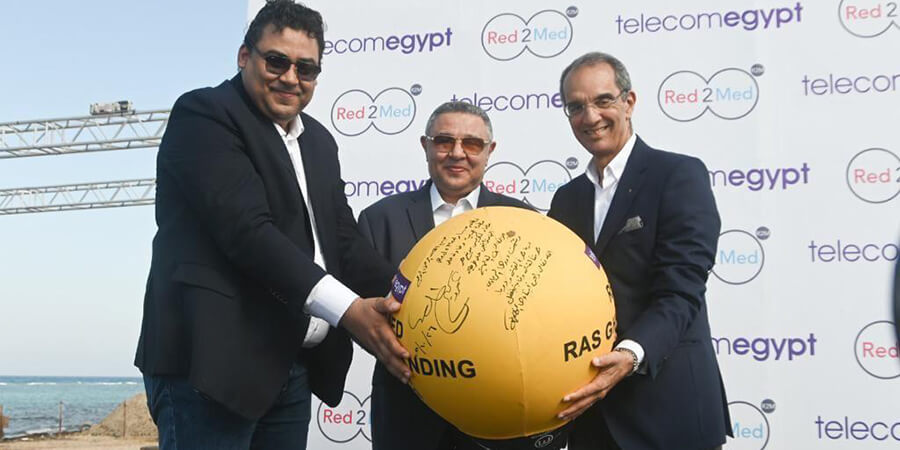The Minister of Communications and Information Technology, Amr Talaat, inaugurated “Red2Med,” a new submarine cable of Telecom Egypt, accompanied by the Red Sea Governor, Amr Hanafi, and Adel Hamed, Telecom Egypt CEO and managing director.
Red2Med runs from Ras Ghareb landing point in the Red Sea to the landing station in Port Said in the Mediterranean Sea, through the Internet Corridor of Egypt (ICE), along the golden route of Morshedeen Road. The cable is the shortest, fastest and most secure way to transfer data between the East and the West. Red2Med is also a breakthrough in the cable routes from East to West and the connection between Africa, Europe and Asia. This project further enhances Egypt’s standing as a global hub for data transmission and raises the efficiency of the international telecommunications infrastructure in Egypt.
Talaat listened to a detailed explanation from Telecom Egypt officials on the company’s future strategic plans to expand its international network through international submarine cables to connect East and West. They highlighted the significance of the Red2Med submarine cable, which runs from the Red Sea through the Suez Canal to the Mediterranean. The ICT minister raised the Egyptian flag the moment the landing ship arrived at the Ras Ghareb coastline, celebrating the successful landing of Red2Med.
Talaat highlighted that the inauguration of Red2Med marks one of Egypt’s milestones in international submarine cables. He added that the Ministry of Communications and Information Technology (MCIT) seeks to leverage Egypt’s exceptional geographic location, a major strategic advantage for the country, as more than 90% of the data passing between East and West crosses the Egyptian lands.
Talaat said that the establishment of the new cable and Morshedeen Road was a long-held dream of the ICT sector. The long-awaited project — some 20 years in development — has been implemented in just a year and is ready to serve countries that rely on Egypt to transfer data, further strengthening the country’s strategic position on this front.
The ICT minister added that the efforts made to develop the information infrastructure have helped to boost the nation’s Internet speed, placing Egypt at the forefront of African countries in median fixed broadband speed.
For his part, Hamed stated that launching Red2Med is a remarkable achievement and a breakthrough in the submarine cable industry, as it cements Egypt’s position as a regional data hub. He added that Telecom Egypt is pleased to offer the new cable system, a brand-new optical path that will encourage and support better international connectivity. He further noted that Red2Med is simply the fastest, shortest and most protected path.
Hamed commended Telecom Egypt’s continuous achievements in extending its international infrastructure. He also praised its continuous investment in new cable systems to increase its network reach and resilience while offering partners unmatched services and solutions.
Red2Med offers a new crossing solution composed of three segments which are detached from the conventional public roads: 1) from the south, the Red Sea subsea festoon cable linking Ras Ghareb, Zaafarana and Suez; 2) then extending to the ICE terrestrial from Suez to Port Said; and 3) finally connecting to the planned Mediterranean Sea subsea festoon cable.
ICE is a 200 km, one-of-a-kind crossing route connecting the new Suez 2 and Port Said 2 landing stations. This new terrestrial fiber optic route runs through the Morshedeen route on the west bank of the highly-secured Suez Canal campus. The Red2Med system offers a seamless route and a brand-new optical path that will encourage and support better international connectivity between East and West, connecting Europe, Africa and Asia.
Notably, Telecom Egypt has made great strides over the past few years in developing its international and local infrastructure to retain its leading position in the Egyptian telecommunications market. At the same time, Telecom Egypt has promoted Egypt’s strategic position in telecommunications, both regionally and internationally as well.
The company invests heavily in the submarine cable infrastructure to provide the shortest and most reliable path to connect Asia, Africa and Europe. It strives to leverage Egypt’s unique geographic location to reinforce its strategic standing as a regional and global focal point for data traffic. This effort strengthens Egypt’s position as a hub connecting Africa and the Middle East to Europe, thus making the country a promising market for the ever-growing data center industry.
To achieve this goal, Telecom Egypt invested about $500 million during the past ten years to strengthen and develop the international infrastructure, including the landing stations and land routes connecting them. The company also invested another $500 million during the same period to expand its network geographically by becoming a member of international alliances, that own submarine cables crossing Egypt. Telecom Egypt’s total investments in infrastructure have reached more than US$1 billion during the last decade.
Telecom Egypt’s efforts culminated in several projects that developed the international communications infrastructure. All were opened by President Abdel Fattah El-Sisi within the framework of his Digital Egypt strategy, and they included the international data center in Smart Village and landing stations in Ras Ghareb, Zaafarana and Sidi Kerir.
The inauguration ceremony was attended by the Assistant ICT Minister for Global Information Infrastructure (GII), Mohamed Nasr Eldin, and officials from Telecom Egypt.
